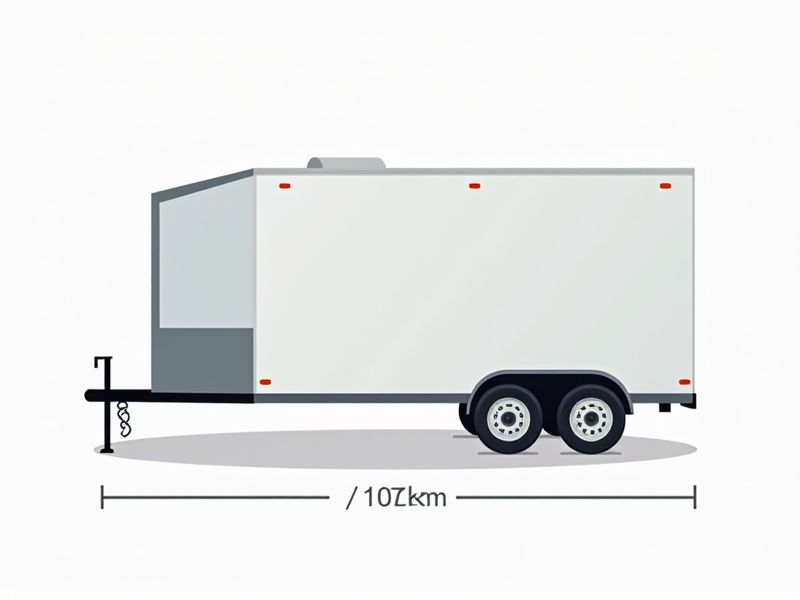
When selecting a trailer, understanding standard dimensions is essential to ensure it meets your hauling requirements. For example, most utility trailers designed for general use are commonly 6 feet by 12 feet, while enclosed cargo trailers typically range from 5 feet by 8 feet up to 8.5 feet by 24 feet. Flatbed trailers, often used for transporting vehicles or larger equipment, are usually 8.5 feet wide and vary in length from 16 feet to 53 feet for commercial applications. Always verify your towing vehicle's capacity and check local regulations, as dimensions and weight restrictions can vary depending on your location and specific use case.
Length Options
Length options for trailers typically range from 10 to 53 feet, catering to various transportation needs. For instance, a 20-foot trailer is ideal for smaller loads, while a 53-foot trailer can accommodate significant cargo, often around 26 pallets. The choice of length affects not only storage capability but also maneuverability and parking requirements; a standard 5th wheel hitch can support most trailer lengths up to 30 feet efficiently. Understanding your load size and type is crucial in selecting the appropriate trailer length to ensure optimal safety and performance.
Width Variations
The standard width for most trailers ranges from 6 to 8.5 feet, catering to diverse cargo needs. A width of 7 feet is common for utility trailers, providing ample space for landscaping equipment or small machinery. For specialized purposes, like car haulers or enclosed trailers, widths can extend up to 8.5 feet, accommodating larger vehicles and protecting them from the elements. Ensuring that your trailer adheres to local regulations regarding width is essential, as exceeding permissible limits can result in fines or operational restrictions.
Height Limitations
Height limitations for trailers typically range between 13.5 feet to 14.5 feet, depending on regulations set by individual states or countries. Exceeding these height standards can lead to fines or restrictions when navigating under bridges or power lines. It's crucial for your trailer to be compliant with the Federal Bridge Formula, which ensures safe passage over bridges while maximizing load capabilities. Regularly measuring your trailer's height and adjusting cargo placement can help avoid potential hazards associated with over-height situations.
Weight Capacity
A trailer's weight capacity, often referred to as its Gross Vehicle Weight Rating (GVWR), plays a crucial role in ensuring safe transportation. This rating typically ranges from 1,000 pounds for smaller utility trailers to over 14,000 pounds for larger models, with many designs specifically engineered to support varying loads. Overloading a trailer can result in decreased braking performance and compromised stability, posing serious safety risks. Always refer to your trailer's documentation to understand its specific weight limitations and ensure you're adhering to these guidelines for optimal performance.
Axle Configurations
Axle configurations are crucial for ensuring the optimal weight distribution and stability of trailers. Common configurations include single, tandem, and tridem axles, with tandem being the most widely used in commercial applications, as it allows for better load management and improved handling. For instance, a tandem axle trailer can typically support up to 34,000 pounds in gross vehicle weight, significantly enhancing its capacity compared to a single axle, which usually maxes out around 16,000 pounds. Understanding these configurations helps you select the right trailer for your hauling needs and ensures compliance with state and federal weight regulations.
Load Regulations
Trailer load regulations necessitate adherence to specific weight limits to ensure safe transportation. The Federal Motor Carrier Safety Administration (FMCSA) sets these limits, which depend on the trailer type; for instance, a standard flatbed typically has a maximum Gross Vehicle Weight Rating (GVWR) of 40,000 pounds. Proper load distribution, ensuring that no axle exceeds 20,000 pounds, is crucial in compliance and enhancing stability during transit. Knowing your trailer's specifications is essential for optimizing performance while adhering to legal requirements, minimizing risks of accidents or penalties.
Material Specifications
When selecting a trailer, pay close attention to material specifications, as they directly impact durability and performance. For instance, trailers with aluminum construction typically weigh 25-30% less than their steel counterparts, improving fuel efficiency and ease of towing. A trailer built with high-strength steel frame offers superior strength, often supporting loads of up to 7,000 pounds without compromising structural integrity. Opting for trailers featuring weather-resistant materials ensures that your investment remains protected against corrosion and wear, significantly extending its lifespan.
Safety Standards
When assessing trailer safety standards, various critical elements are paramount, including braking performance, load capacity, and hitching mechanisms. The National Highway Traffic Safety Administration (NHTSA) mandates that trailers must comply with specific weight limits, often capped at 3,000 to 5,000 pounds for light-duty trailers, ensuring safe towing practices. A robust braking system is essential; for instance, trailers over 3,000 pounds typically require electronic or hydraulic brakes to enhance stopping power. Furthermore, manufacturers are required to label trailers with Gross Vehicle Weight Rating (GVWR), which indicates the maximum weight the trailer can safely handle, significantly reducing the risks associated with overloading.
Coupling Systems
The coupling systems in trailers are crucial for ensuring stability and safety during transportation, with a common weight capacity ranging from 2,000 to 30,000 pounds. Most trailers utilize either a bumper pull or fifth-wheel coupling system, each offering specific advantages for different towing needs. For instance, fifth-wheel systems provide better weight distribution and maneuverability, making them ideal for heavier loads. Regular maintenance checks on these systems can prevent potential failures and enhance your towing experience, underscoring the importance of investing in high-quality components.
Licensing Requirements
Understanding the licensing requirements for trailers is essential for compliance and safety. Different regions typically mandate specific licenses that depend on the trailer's weight and usage; for example, in the U.S., a Class A or B commercial driver's license may be necessary for trailers exceeding 10,000 pounds. You should also verify local regulations, as some states require additional permits or special endorsements for hauling certain cargo types. Ensuring you meet these licensing standards not only avoids legal penalties but also enhances operational efficiency.
